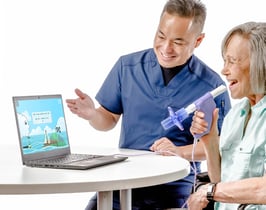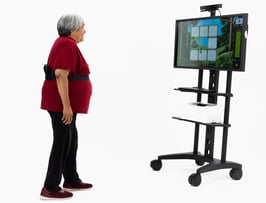According to the CDC, more than 25% of older adults fall each year. Muscle strength and balance decline with aging which can lead to falls and diminished quality of life.
In a comprehensive fall prevention and balance program, physical and occupational therapists can assess strength of core musculature and static/dynamic standing balance. Interventions that include virtual reality (OmniFlow® and OmniVR®) motivate patients to work at higher intensity and longer durations resulting in improved outcomes.
OmniFlow® Breathing Therapy Biofeedback System used with diaphragmatic breathing techniques can improve core stability and balance. Breathing exercises to strengthen the diaphragm can contribute to core stabilization and improved balance.

|
|
OmniVR® Virtual Rehabilitation System used with static and dynamic standing activities can improve balance and gait. Daily activities require static/dynamic standing balance be maintained to prevent falls.

|
|
Cavaggioni, L., Ongaro, L., Zannin, E., Iaia, F. M., & Alberti, G. (2015). Effects of different core exercises on respiratory parameters and abdominal strength. Journal of Physical Therapy Science, 27(10), 3249–3253. https://doi.org/10.1589/jpts.27.3249
Ferraro, F. V., Gavin, J. P., Wainwright, T., & McConnell, A. (2019). The effects of 8 weeks of inspiratory muscle training on the balance of healthy older adults: a randomized, double-blind, placebo-controlled study. Physiological Reports, 7(9), e14076. https://doi.org/10.14814/phy2.14076
Sarasso, E., Gardoni, A., Tettamanti, A., Agosta, F., Filippi, M., & Corbetta, D. (2022). Virtual reality balance training to improve balance and mobility in Parkinson’s disease: a systematic review and meta-analysis. Journal of Neurology, 269(4), 1873–1888. https://doi.org/10.1007/s00415-021-10857-3
Zahedian-Nasab, N., Jaberi, A., Shirazi, F., & Kavousipor, S. (2021). Effect of virtual reality exercises on balance and fall in elderly people with fall risk: a randomized controlled trial. BMC Geriatrics, 21(1), 509. https://doi.org/10.1186/s12877-021-02462-w
